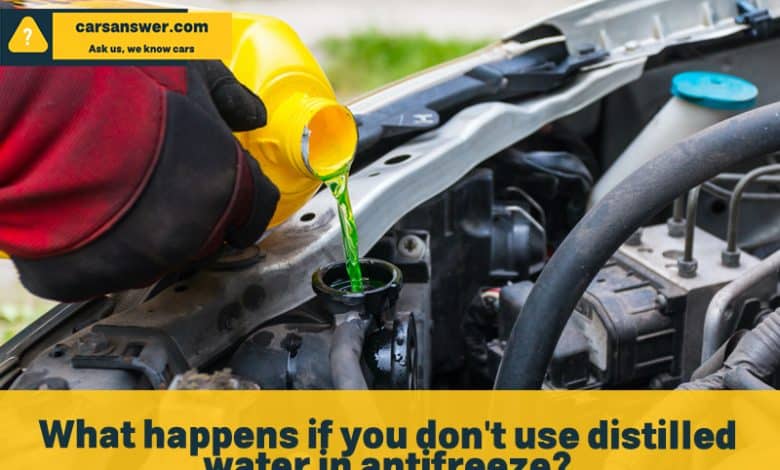What happens if you don’t use distilled water in antifreeze?

Antifreeze is an important component of a vehicle’s cooling system that prevents the engine from overheating. It is typically made from a mixture of water and ethylene glycol or propylene glycol. However, many people wonder what happens if you don’t use distilled water in antifreeze. In this article, we will explore the effects of using non-distilled water in antifreeze and why distilled water is the preferred choice.

Why is distilled water recommended for antifreeze?
Distilled water is recommended for use in antifreeze because it is free from minerals, chemicals, and impurities that can damage the engine. Impurities in non-distilled water such as calcium, magnesium, and iron can react with the antifreeze and form deposits in the cooling system. These deposits can clog the radiator and other parts of the cooling system, reducing its efficiency and causing the engine to overheat. Additionally, tap water or other types of water may contain chlorine or fluoride that can also react with the antifreeze and damage the engine.
What are the effects of using non-distilled water in antifreeze?
If non-distilled water is used in antifreeze, it can cause several problems with the engine and cooling system. The minerals and impurities in the water can react with the antifreeze, causing deposits to form in the radiator and other parts of the cooling system. These deposits can clog the system, reducing its efficiency and causing the engine to overheat. The deposits can also cause damage to the water pump, thermostat, and other parts of the cooling system.
In addition to causing deposits to form, using non-distilled water can also cause corrosion and other types of damage to the engine. The chemicals and minerals in the water can react with the metal components of the engine, causing them to corrode and wear out more quickly. This can lead to leaks and other types of damage that can be costly to repair.
Signs of antifreeze contamination
If antifreeze has been contaminated with non-distilled water, there are several signs that may indicate a problem with the engine or cooling system. These signs include:
- Overheating: If the engine is overheating or running hot, it may be a sign that the cooling system is not working properly.
- Rust or corrosion: If you notice rust or corrosion on the radiator, hoses, or other parts of the cooling system, it may be a sign that the antifreeze has been contaminated.
- Deposits: If you see deposits or sludge in the radiator or other parts of the cooling system, it may be a sign that the antifreeze has been contaminated.
- leaks: If you notice leaks in the cooling system, it may be a sign that the system has been damaged by contaminated antifreeze.
How to prevent antifreeze contamination
To prevent antifreeze contamination, it is important to use distilled water when mixing antifreeze. Distilled water is free from minerals and other impurities that can react with the antifreeze and cause damage to the engine. It is important to note that using tap water or other types of water can void the warranty on the cooling system.
Additionally, it is important to flush and replace the antifreeze at regular intervals to prevent the buildup of deposits and other contaminants. The recommended interval for flushing and replacing antifreeze varies by vehicle, but it is typically every 2 to 5 years or every 30,000 to 50,000 miles. It is important to follow the manufacturer’s recommendations for your specific vehicle.
How to flush and replace antifreeze
Flushing and replacing antifreeze can be a DIY project or can be done by a professional mechanic. To flush and replace the antifreeze, follow these steps:
- Allow the engine to cool down completely.
- Locate the radiator drain plug or petcock and open it to drain the old antifreeze. Be sure to catch the antifreeze in a container and dispose of it properly.
- Close the drain plug or petcock and fill the radiator with distilled water.
- Turn on the engine and allow it to run for 10 to 15 minutes with the heater on high.
- Turn off the engine and allow it to cool down completely.
- Open the drain plug or petcock again to drain the distilled water from the radiator.
- Close the drain plug or petcock and refill the radiator with the recommended type and amount of antifreeze for your vehicle.
- Check the antifreeze level and top off if necessary.
Conclusion
In conclusion, using non-distilled water in antifreeze can cause several problems with the engine and cooling system. The minerals and impurities in the water can cause deposits to form and clog the cooling system, while the chemicals and minerals can cause corrosion and other types of damage to the engine. To prevent antifreeze contamination, it is important to use distilledwater when mixing antifreeze and to flush and replace the antifreeze at the recommended intervals. Signs of antifreeze contamination include overheating, rust or corrosion, deposits, and leaks. By using distilled water and following the manufacturer’s recommendations for flushing and replacing antifreeze, you can help ensure that your vehicle’s cooling system runs smoothly and efficiently. Proper maintenance of the cooling system is essential for safe and reliable driving , so it is important to prioritize this aspect of vehicle care.





